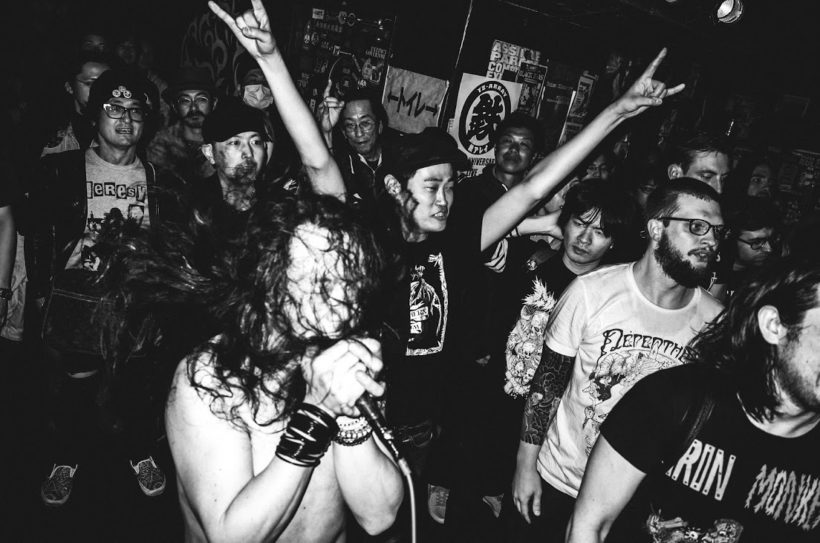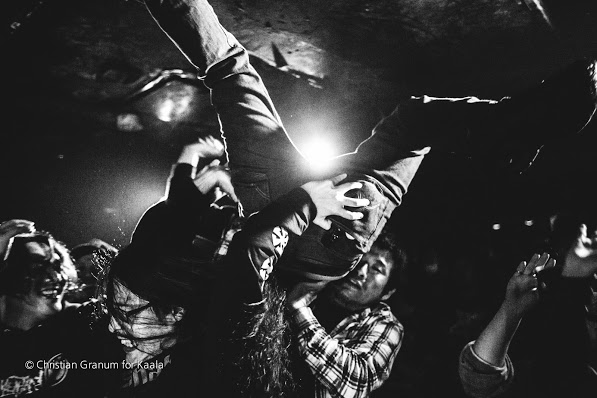
Matt Ketchum, the founder of Japan-based English-language metal resource Kaala, has a wake-up call for those enjoying Netflix’s ‘Aggretsuko’.
Like many Netflix subscribers, I’ve been taken in by the animated series with a penchant for power violence. Its story revolves around Retsuko, a red panda who is put down by her sexist boss and blows off steam by singing grindcore and death metal in karaoke bars. It’s cute. It’s relatable. What’s the problem?
“Here’s the problem,” Ketchum tells me over beers. “She spends all this time screaming in a karaoke booth. She has no community. But in Japan, there’s a thriving metal scene.”
Why Don’t More Americans Know More About the Metal in Japan?
Decibel readers may be peripherally aware that Japan has a long and storied extreme metal history. Some contemporaries like Coffins have a fanbase in America. Bands like Sigh and Abigail began making black metal around the same time as their Norwegian counterparts. Before them, Loudness made waves as the nation’s most internationally popular hair metal act. Flower Travelin band wrote the “Raining Blood” riff while Black Sabbath was not yet “Paranoid.”
For the most part, though, Americans remain in the dark on Japan’s metal underground. “There are three thousand bands in this country people would love it if they got their hands on it but they don’t have any access to it,” Ketchum says.
After almost a decade living in Japan, embedded in Tokyo’s extreme metal and hardcore punk underground, he probably has a more accurate survey of the Japanese metal scene than any English language journalist his age.
Ketchum has a laundry list of reasons for why the average American metal fan can probably name more bands from any given European country than Japan. “There is a language barrier, there is also a cultural barrier. The propagation of information about this stuff mostly exists on 1997-style websites. You can’t find out about it unless you already know where it is.” According to Ketchum, the information gap affects not just Japan, but almost all of Asia, including Russia.
Fortunately, Ketchum also has a solution for this cultural gap: metal-oriented tourism.
Bridging the Cultural Rift… With Riffs

Through Kaala, Ketchum is organizing trips to Japan oriented around exposing American audiences to Japan’s extreme metal underground, His first tour leaves this Friday, May 18, and will last ten days. During that time Ketchum will escort Americans to a Kaala-organized 10 band mini-fest called the Tower Vol. 2, as well as other concerts by bands like Retch and legendary Burning Spirits hardcore outfit Forward. These events will take place in small 200-cap venues, ensuring an intimate and immersive exposure to another country’s interpretation of extreme music.
At this point in time, I’m guessing many readers are saying to themselves ”Well that sounds interesting, but it also sounds very expensive.” That was my reaction, as well. However, Ketchum insists he can get Americans to Japan’s metallic underbelly for a reasonable sum.
For example, for Seattleites such as myself, Ketchum estimates that a trip to Maryland Deathfest (which is going on at the same time as his inaugural tour) could cost as much as $2500 including beer, merch, food, hotel, and travel. Ketchum believes he can keep the ten-day trip to Japan substantially cheaper.
While Kaala’s first metal-oriented tourism trek coincides with one of the group’s own events, he says future trips may be organized around other festivals, such as the ascendant Asakusa Deathfest.
Improving International Relations One Hesher at a Time

According to Ketchum, choosing to spend ones metal-related travel time abroad comes with an added benefit. Travel can reinforce metal fandom as an international identity, one that circumvents race and nationalism, and could strengthen the inner human connection between those of us in battle vests.
“There are experiences around the same price point as these domestic experiences [like Maryland Deathfest] where it is reasonable to expect that the trip would contribute to these great conversations about relating between nationalities, races, cultures,” he says. “What we’re trying to do is open minds to audacious social experience and from that, an actual conversation can be had about where we’re going, how we can go about making a better world.”
Step one to that better world? Getting American heshers on a plane over the Pacific. Ketchum thinks it will be much easier and more valuable than getting Retsuko out of her karaoke booth. “Go out there, get uncomfortable. The food is different the language is different but especially in underground music venues, all that shit subsides. If you can wear a black tee shirt, drink a beer and hi-five somebody, you can travel the world.”
Those interested in future tourism opportunities with Kaala can get more information here.
You can visit Kaala’s website here, and follow them on Facebook, Twitter, and Instagram.
All photos in this article were taken by Christian Ganum at Earthside, a venue in Tokyo.






